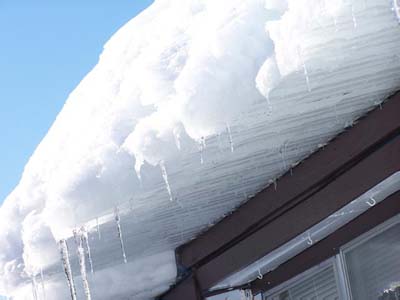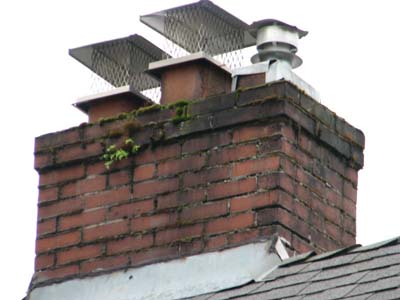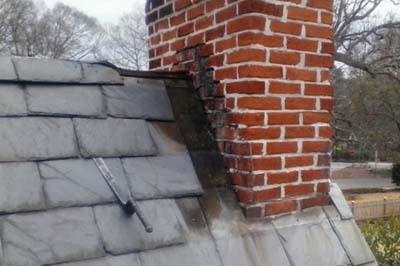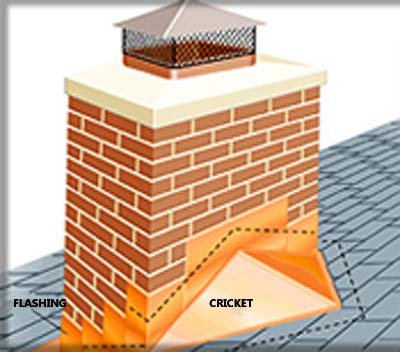WATER EROSION DAMAGE TO YOUR CHIMNEY
Water Erosion Damage
- How the Water Gets In your Chimney or Chimney Stack
- If you do not have a properly installed cap, rain water can easily drip down inside your chimney. Even if the cap is installed properly, chimney erosion can still occur simply from rain water dripping inside from the top.
If you live in an area that snows a
lot, snow can melt and also easily
trickle into your chimney. It might take a couple of years but it is entirely possible for rain water
or snow to enter from even a small opening at the top.
It's not so hard to imagine when you
take a look at the amount of snow
that can accumulate on your roof
after just one storm.
 Additionally, if there are cracks in the mortar crown, or chimney flashing water can easily seep in through the cracks. Another cause of water damage is if you do not have a chimney liner, condensation from chimney fumes can occur on the interior and adhere to the bricks. If you have water stains on your paint or wall paper on the interior of your house near the chimney, it is likely condensation. All forms of water entering your chimney are extremely hazardous to the chimney. If you see any signs of water damage, it is an indication of some of these other issues I have listed above that needs to be repaired before using lighting another fire.
Additionally, if there are cracks in the mortar crown, or chimney flashing water can easily seep in through the cracks. Another cause of water damage is if you do not have a chimney liner, condensation from chimney fumes can occur on the interior and adhere to the bricks. If you have water stains on your paint or wall paper on the interior of your house near the chimney, it is likely condensation. All forms of water entering your chimney are extremely hazardous to the chimney. If you see any signs of water damage, it is an indication of some of these other issues I have listed above that needs to be repaired before using lighting another fire. - Damage that Water Erosion can create to your Chimney
- Water erosion will cause cracks and gaps in your flue tiles or mortar joints of the exterior of your chimney stack. This is especially likely if you live in a climate that goes below freezing, the freeze/thaw effect will create cracks quicker as water gets trapped in crevasses and expands when it freezes. Once cracks are present, they must be repaired before starting another fire in your chimney. Water in the chimney causes rust in steel and cast iron, weakening or destroying the metal parts such as the firebox assemblies. Water also rots and clogs components of the chimney and can cause tilting or collapse of supportive structures if severe enough. Water will also pool on the smoke shelf, mix with the creosote/soot behind the damper, and form an acidic sludge that seeps into the fire back destroying the mortar joints. If neglected long enough, water damage can deteriorate your entire heating system and become very costly. If you notice any of the signs of water damage, have them inspected immediately to prevent further damage.
- Dangers of Water Damage to your Chimney
-
Beyond creating rust, decay, clogs, and stains, water in the chimney will cause cracks and structural damage that allow combustible materials to reach your house. You are risking a chimney fire that could spread to the rest of your house if you light a fire in a chimney with water damage. Deteriorated chimneys also allow carbon monoxide emissions to your home through the cracks and gaps which can be harmful and even deadly. Severe damage can also lead to rotten wood and decayed mortar that is so bad, your chimney collapses. It could fall and cause additional damage to your roof, or land on something surrounding your home that is equally as destructive. If you believe you have water damage, it is important to have it repaired now so that the problem does not turn into a dangerous safety problem.

- Water Proofing your Chimney
-

- So, you know you have water damage in your chimney and now you need to figure out what to do about it. There are a number of different repairs that your professional chimney sweep will recommend and it depends on the amount of damage you have as to what solution is best.
- • One of the simplest preventative solutions to rain and snow from entering the chimney flue is to install a chimney cap. There are many caps available to cover your chimney whether it is single flue, you have multiple flues, or you want to cover the entire chimney top. This is an inexpensive preventative measure for water damage.
- • Another simple preventative solution to prevent rainwater from the roof is to install a cricket (aka saddle flashing). A cricket is a water deflector that directs rainwater away from the chimney by attaching to the base of the chimney on the side that could collect water because the chimney is on a steep sloped roof and water drips down to the chimney and collects in a pool at the base of the chimney. Crickets are recommended for chimneys that are more than 30 inches wide and they are especially useful on steep roofs.

- • Another preventative measure is applying a waterproofing material to the exterior of your chimney. It is best to use polysiloxane rather than silicone. Polysiloxane is just as strong of a waterproofing agent, but it also lasts longer, has low solar absorption, low VOC content, and is corrosion and chemical resistant, making it safe. Finally, it is 100% vapor permeable, which means that they allow the chimney bricks to breathe. Applying polysiloxane should be done in the beginning of construction or after repairs to fix prior water damage.

- • Repair measures are more expensive and include the following: replacing a damaged chimney crown, replacing deteriorated mortar joints (tuckpointing), installing a new chimney liner or flashing. Please see our chimney services pages to get a better idea of how these repairs are performed by your professional chimney sweep. If you suspect you have water damage, it is best to get it inspected by a professional chimney sweep to understand what the actual issue before you start one more fire in your fireplace.
